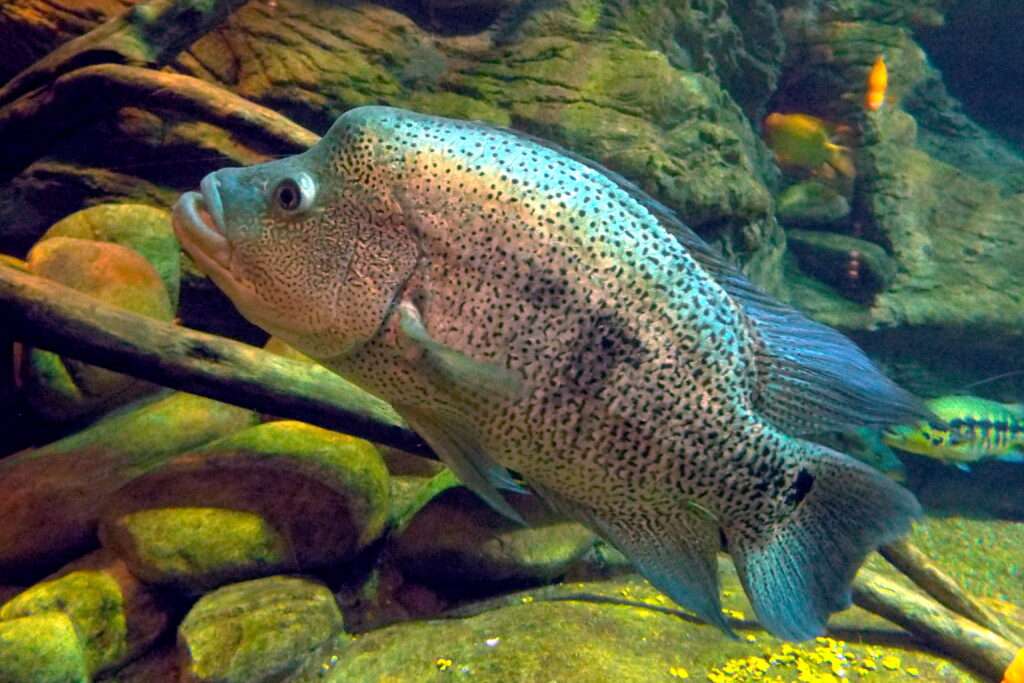
Size
Up to 28 inches
Physical Characteristics
The Wolf Cichlid species are tough enough to fight other large fish thanks to their muscular build. Black basses and Wolf Cichlids share a similar appearance, although the latter have a single nostril on each side of the head. They also have a big mouth and a dual section discontinuous lateral line. The male cichlids have a color pattern that combines golden yellow with a silver backdrop that is flecked with small amounts of purple, black, and blue. Cichlid females are typically yellow in hue.
Temperament
They are among the industry’s most aggressive people. Most aquarists keep these fish in isolation because they are not community fish. In a sufficiently large tank, it is theoretically possible to keep several together, although there is always the possibility of territorial aggressiveness.
Any fish or vertebrate that stands in its way will be attacked and killed by this species. It frequently misinterprets smaller animals as prey and attacks anything it perceives as invading its domain.
Habitat
Native to Central America, the wolf cichlid can be found on both the Atlantic and Pacific slopes, from the Yeguare River in Honduras to the Bebedero River on the Pacific slope and the Aguan River in Honduras, respectively (Costa Rica).
Keeping as Pet

- Tank Size
150 gallons is the smallest tank size you ought to think about. For its first few years, your fish may be fine in a tank that has a capacity of 100 gallons. You’ll need to upgrade to 150 gallons or more as it approaches that mature size, though.
- Water Conditions
What matters most is stability. Wolf cichlids can endure occasional minor shifts, but abrupt big changes might cause undue stress and health issues. Follow these guidelines and keep an eye on the water’s conditions to keep the environment stable for the duration of your fish’s life to prevent that.
Temperature of the water between 75 and 82 degrees Fahrenheit (Near neutral) is optimum
pH levels between 6.8 and 7.6 are o
20 DH water hardness (hard water)
- Feeding
Wolf cichlids are purely and simply carnivorous fish! They enjoy eating meals that are high in protein, and they won’t think twice about pursuing feeder fish and other live food sources. Cichlid pellets are the most accessible food you can offer. They have a balanced nutritional profile, and several formulations highlight the species’ vibrant color.
Consider occasionally offering live or frozen nibbles as a supplement to commercial meals. Excellent choices consist of: Earthworms, Bloodworms, Lance fish, Mussels, Shrimp, Crawfish, Feeder goldfish, Crab, Silversides, Beef heart and Diced fish.
- Tank mates
Not all fish species get along well with the Dovii Cichlids as tank mates. In a sufficiently sized tank, they are typically best kept alone or as a mated pair. Other Dovii Cichlids kept in the aquarium will be wiped out by the dominating male.
Only a larger fish with a similar temperament who is large enough to avoid being devoured can be kept in the same tank as the Dovii Cichlid. The Dovii Cichlid cannot coexist with predator species like the red devil cichlid, piranha, flowerhorn cichlid, oscar cichlid, or even snakehead fishes. If these other cichlid species must be housed in the same aquarium tank, careful monitoring is required.
Table





